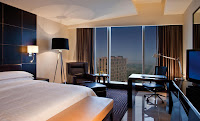Since the beginning of time hotels have known how to attract their guests
with different customer experiences or different environments where the customers
feel better. As (LeBoeuff, 1987) suggests that the more
customers can see, hear, touch, smell, taste, and feel how wonderful it is to
buy what you sell, the more value they will perceive and the more likely it is
they will buy. Based on this fact most hotels look forward to a good first impression
when they are welcoming the customers. A good environment, where the customer
feels like home will most likely make him talk about it to other people.
It’s important
for a hotel to make a good first impression by investing in the hotel’s design because
the value of design for budget hotels comes in the development of the room
module which is, in many ways, the ultimate test of good product design. External
appearance influences perceptions of product quality, and therefore has a key
role to play in adding value. Refurbishment of bedrooms, for example, usually
has to take place every seven years to cope with wear and tear.
As time passes
customers are expecting more modern hotels where they can stay during their
journey. That’s why, overtime, wooden furniture and red velvet patterns were
replaced by warm colours and a more relaxed style. The use of technology also
became one of the important characteristics that a customer is looking for. Customers
are more likely to check-in at a hotel that can provide technology friendly
services and where they can relax but in the same time be in touch with
everything around them. One of items might be a laptop friendly bedside table
or Bluetooth speakers besides their bed. Customers these days are looking for a
more dynamic place to stay and they want to do things faster and easier.
One of the
designs applied by some of the Asian hotels is the Chil-Bo, which is one of the
traditional Korean designs for furniture ornamentation. The original design has
been extruded into cubic forms to stand out and be mounted on the facade of the
wall behind the front desk counter and in the lobby lounge. A yellow colour has
been applied to the symbol at the front desk because it possesses high
visibility in contrast with the reddish brown wood panelled wall. This being
regarded as one of the most important philosophies in redesigning this hotel,
the visual communication replaces any written or verbal advertisement.
References
“How to Win
Customers and Keep Them for Life” by Michael LeBoeuff, (1987)
"Hotel
Design: Renovation", Chong, Hye Sue, (1998)
"Hotel
Design: The Need to Develop a Strategic Approach", Amanda West Elizabeth
Purvis, (1992), International Journal of Contemporary Hospitality Management,
Vol. 4
"What is
“good” hotel design?", Josef Ransley Hadyn Ingram, (2001), Facilities,
Vol. 19 pp. 79 – 87


Niciun comentariu:
Trimiteți un comentariu